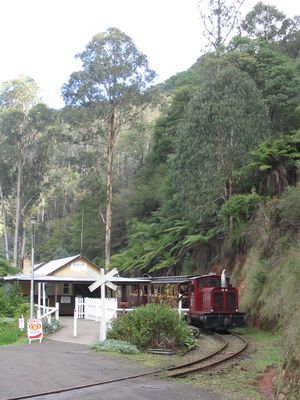Walhalla Goldfields Railway
| Melbourne's public transport | |||
|---|---|---|---|
| Metlink | Metcard | myki | |
| Modes of Transport | |||
| Trains | Trams | Buses | |
| Transport Routes | |||
| Railway stations | Tram routes | Bus routes | |
| Operating Companies | |||
| V/Line | Connex Melbourne | Yarra Trams | |
The Walhalla Goldfields Railway is a narrow gauge (2 ft 6 in (762 mm) gauge) tourist railway located in the Thomson River and Stringers Creek valleys in Gippsland, Victoria, Australia, near the former gold-mining town and popular tourist destination of Walhalla.
Contents
History
The last of four experimental narrow gauge lines of the Victorian Railways, construction of the Moe-Walhalla railway began in 1904, but was not completed until 1910 due to the difficult mountainous terrain to be contended with. The railway was expected to be a boon for the town, which was in a state of economic and population decline due to gold mining operations becoming increasingly uneconomical, the largest gold mining company closing in 1914. But the arrival of the railway did not save the town.
After the closure of the Walhalla mines, substantial timber traffic was carried from sawmills in the Erica area until the late 1940s. Although the line carried numerous special passenger trains to Walhalla in the 1930s and early 1940s, freight and passenger traffic to Walhalla itself declined to almost nothing by 1939. The railway was closed in sections from 1944-54, the section from Platina to Walhalla closing in March 1944 and the final section from Moe to Erica eventually closing on June 25 1954. The tracks and buildings were removed by 1960, leaving only the roadbed and a number of bridges.
In recognition of the outstanding tourist potential of the railway, a number of attempts were made to reopen the line for tourist traffic, but none were successful until the early 1990s. The Walhalla Railway Taskforce was formed in 1991, becoming the Walhalla Goldfields Railway, Inc., in 1993. By this time the former roadbed was a totally overgrown jungle of blackberries and heavy scrub, with numerous sections of the trackbed having collapsed and all but one of the bridges being totally derelict. Restoration began with the establishment of Thomson Station and its accompanying yard on the site of an original station. The railway commenced operations in April, 1994, within the Thomson Station yard. Gradually the line progressed, first over the nationally-heritage-classified Thomson River Bridge in October 1994, pushing up the Stringers Creek Gorge to Happy Creek. This became the terminus for the line until the six bridges in the last kilometre into the Walhalla Station yard were completed, this section of line opening on 15 March, 2002. The operating line is 4 km in length.
Due to the high fire danger and the presence of bushfires elsewhere in the nearby mountains, services on the railway were suspended as from the weekend of 9 December 2006[1]. By 18 December 2006 the fires had reached the outskirts of Walhalla, and on 22 December 2006 fire destroyed the three-span trestle bridge ("bridge 7") adjacent to the former temporary terminus known as Cascade Bridge Halt[2]. Services resumed between Walhalla and Happy Creek on 31 December 2006.
Current operation and rollingstock
The Walhalla Goldfields Railway operates regular tourist services between Thomson and Walhalla stations, using both steam and diesel locomotives. Notably, the railway carries far more passengers as a tourist railway than it did in its time as an operating revenue line, around 30,000 passengers travelling on the service each year - comparing with an average of around 1,000 each year during its original lifespan.
Due to the unavailability of original rolling stock from the railway (some of which is still in use on the Puffing Billy Railway near Melbourne), locomotives have been acquired from a variety of locations, including two small industrial diesel engines from the Gippsland area, a larger diesel engine from the Emu Bay Railway in Tasmania and a small Henschel & Son steam locomotive built in Kassel, Germany but used in a sugarcane plantation in Thailand. The passenger rollingstock was constructed from the frames and bogies of a now closed 900mm gauge coal line at Yallourn, 40km south of Walhalla. The buildings and new rollingstock have been designed to reflect the original Victorian Railways design standards as closely as possible.
While the railway has drawn some uninformed criticism for deviation from historical accuracy regarding its rolling stock, the collection is a significant piece of industrial railway history, and the WGR provides a valuable tourist train service for the local economy.
Future expansion plans
The WGR is currently examining the possibility of extended the line to Platina and eventually to Erica, with funding applications currently in progress following the conclusion of engineering assessments. The line reservation from Erica to Moe has been sold in many places and has a reservoir partially covering it, so it is not possible to fully rebuild the line, notwithstanding the fact that such an extension would be uneconomic.
Stations
* Temporary stations during reconstruction of the railway.
Trivia
The former station building at Walhalla was re-located to the Melbourne suburban station of Hartwell, where it still exists, albeit heavily modified.
The centre span of the National Estate listed Thomson River Railway Bridge was formerly part of a road bridge over the Murray River at Tocumwal (NSW). The website of the Australian Heritage Commission confirms this fact.
External links
- Walhalla Goldfields Railway (official site)
- Pictures from around the Walhalla Goldfields Railway (unofficial)


